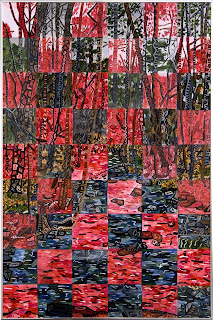
In depicting elements in nature relief effects give a 3-dimensional effect that really makes the paint “pop” right off the canvas. In this painting technique I am using Matisse Structure paint (Carbon Grey) along with Matisse Impasto Medium to create tree bark.
Step 1: I mix a ratio of about 30% paint with 70% Impasto Medium. Make sure the mixture is throughly mixed (I use a palette knife) when complete the mixture should be the color of the paint.
Step 2: Apply as much masking tape as needed over the area where the impasto mixture will be applied. In this instance a width of about 4” of tape is used. I generally use more tape than is actually needed so the excess will catch any spillage in the removal process.
Step 3: Once the tape is applied I use an Exacto knife to cut out various shapes, It is important to use a sharp exacto knife and a heavweight canvas, otherwise you risk cutting right through the canvas
Step 4: Once the tape is prepared I use a palette knife and begin applying the impasto mixture. I like to use alot of the mixture, the impasto medium can hold peaks of about an inch. One applied you can use the knife to smooth out the mixture, or you can leave rough or even add some textured details when the mixture is still wet.
Step 5: When the mixture is still wet begin lifting the layers of tape off. Be sure to lift the layers by the outer layer first, otherwise you risk lifting all the layers at one and creating a mess.
When complete the Impasto mixture will take about 24 hours to fully dry. During this drying period you can add texture and subtly shape the peaks. Once dried, the peaks can be painted over just as if they were another layer of paint.









